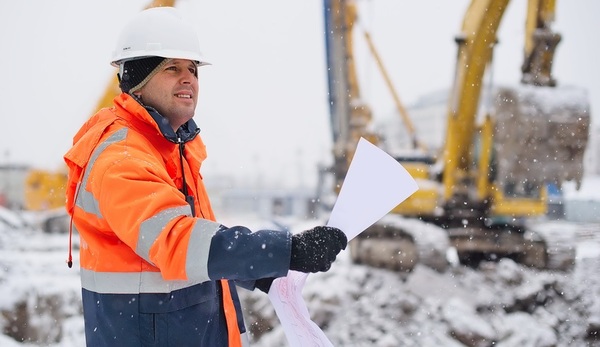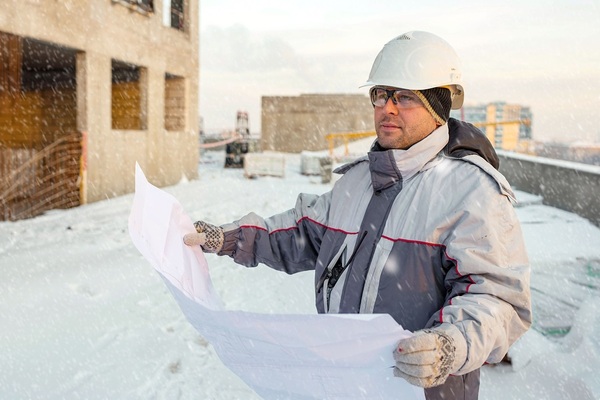Winter weather can be unpredictable, and in the case of a construction job site, potentially deadly. Construction experts who have been in the industry for years never take anything for granted when it comes to preparing for the winter. They also do their best to drive the point home with their workers that they need to be extra careful when the conditions get cold and icy.
Most construction companies have procedures they follow as they prepare for the winter, but that doesn’t mean their policies are comprehensive. One forgotten detail could lead to a serious accident and possible injuries. Instead of taking any chances, it’s best to review as many of the best ways to prep construction sites for winter work as possible.

It’s important that your construction company plan for the winter weather.
Prepare For Work Stoppages
It’s unreasonable, and a bit unfair, for a construction company to assume that there will be no problems with working a regular schedule during the winter weather. As part of your preparations for winter work, you need to plan for some unexpected days off due to icy conditions, high winds, or bad visibility. If you plan in advance, you may be able to work it out with your crew that if you are snowed out on a Tuesday, you could make it up on Saturday. Unions often have regulations for this sort of thing, so be sure to check with the union representative to see if such an arrangement is allowed.
Plan For Icy Conditions
Installing a fence or laying down erosion control blankets is almost impossible to do property when the ground is frozen. Plan your project so that you take care of any ground-related processes before the ground freezes. You will also want to be prepared to take care of the muddy conditions that will occur when the ground starts to thaw. A little advance planning can help to keep your machinery from getting bogged down in the mud.
Walking On Icy Conditions
Even on a flat surface, scaffolding installed on the icy ground can slide around during regular use if it is not properly anchored. Since you cannot anchor your workers to the ground, you need to make sure that your employees all have the proper kind of footwear to work in icy conditions. One way to inspire employees to make sure they have the right boots for the conditions would be to send workers home until they get the right foot gear. You should also encourage your workers to take small steps and avoid long strides to avoid falling on ice.
Keeping Workers Warm
It can happen that the weather gets so cold during the winter that not even a well-prepared employee is able to handle the conditions for a full shift. The answer is to set up small warming stations with warm drinks throughout the job site to give workers a place to go to avoid cold-related medical issues.
Be Careful With Snow Plowing
Roads and sections of the job site that need to be plowed should be clearly marked so that equipment is not left behind. Being trapped in ice and snow for months will render your electrical equipment useless, so be sure employees know where the plow areas are. Your plow drivers should pile the snow at the top of inclines so that the snow runs away from the site when it melts instead of back into the site to create a muddy mess.
Don’t Fight Really Bad Weather
In areas where winter is a recurring season, experienced contractors have developed safe ways to keep the projects going and avoid lost time. But even the most experienced contractors know that Mother Nature is not going to step aside for a construction project, which means that truly bad weather is not something to tangle with. If the weather gets especially bad, then you should plan on working indoors if possible. With some advance planning when it comes to taking on work and planning the progression of each stage of a job, you can do a lot towards making sure that outside work is done sparingly during the winter months.
Always Train For Winter
One of the more definitive rules OSHA has about winter prepping for construction sites is to make sure that all of the appropriate employees have been trained in how to operate equipment during the winter months. You can use your parking lot as it ices over to train employees how to safely navigate icy areas with the large equipment, and you can also have experienced drivers shadow inexperienced operators to give tips on how to safely use construction vehicles and equipment in the winter weather.

Protect your workers with comprehensive policies for winter jobsite prepping.
Know Your Winter Construction Rules
Certain types of concrete are much more accustomed to the cold weather, while carpentry in the cold is always a bad idea. From all of the construction methods you use to the materials that are part of the project, it is critical that every construction company understands the proper materials and methods to use to get the best results during the winter.
Account For Ditches And Hills
When the snow is on the ground, your job site can look like a perfectly level field. But when you start driving equipment around, you soon discover plenty of ditches and hills to make things difficult. Before the snow flies, you need to spend time filling ditches in with stone and marking them and marking the more significant hills to make sure that your equipment does not get damaged or caught up on the terrain.
Winter can create a long list of issues that construction companies must deal with to maintain productivity and keep the construction site safe. Even if your company has years of experience working in the winter, it never hurts to review your winter prepping plans to make sure that you have everything covered. If you do not have a comprehensive and written winter prepping plan, then it is critical that you create one.
You can start a course with PDH Contractors to learn more about prepping for winter and worker safety. The information offered by PDH Contractors can be invaluable to the long-term success of your construction organization.
